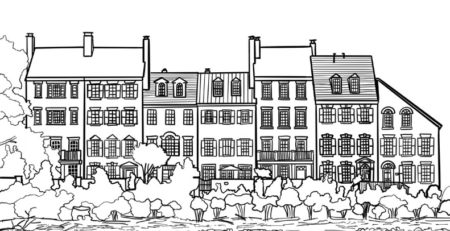How Does Air Quality Affect Property Prices?
Due to the implications for human health, as data on the places where air pollution is most concentrated continues to accumulate, property values are expected to be influenced as well.
There is just around a 12-kilometer-thick layer of gas covering the planet’s atmosphere at its thickest point. This thin, life-giving atmosphere is so thin that it vulnerable to the pollutants we add to the atmosphere. Air pollution has been a major health concern in recent years and is growing.
Air pollution is a leading cause of mortality, affecting 8.8 million people worldwide each year. According to a joint report by the Royal College of Physicians and the Royal College of Paediatrics and Child Health in 2016, approximately 40,000 individuals in the UK die prematurely each year as a result of air pollution.
According to the World Health Organization (WHO), air pollution costs the UK economy an estimated £54 billion a year, or around 3.7 percent of GDP. Some European nations have considerably higher levels. For example, in Bulgaria, it is reported to be a staggering 29.5% of GDP. About 91% of the world’s population lives in locations where air quality exceeds WHO standards for major air contaminants.
Smoke and sulphur dioxide from the burning of fossil fuels have long been the primary sources of air pollution in both industrialised and industrialising countries. Pollutants such as carbon monoxide, nitrogen oxides, volatile organic compounds (VOCs), and fine particulate matter (PM10) such as tyre wear and brake dust (which also affect food sources) are currently the most significant threat to clean air, and this is mostly due to traffic emissions from gasoline and diesel cars and trucks. There is a growing influence on urban air quality, and increased air traffic is also contributing.

The production of non-exhaust particulate matter by electric cars is comparable to that of internal combustion engines, despite the fact that they are typically touted as having zero emissions. So, switching from cars that run on fossil fuels to cars that run on electricity does not guarantee that particulate pollution will go away.
As a result, while automobiles do not produce carbon dioxide, power plants do, giving the impression that they are environmentally friendly. In reality, they have just shifted emissions into the background and out of people’s consciousness. Renewable energy sources, of course, can somewhat counterbalance this, but only partially. We will still need fossil fuels in the short to medium term to meet the needs of homes and businesses.
Heathrow Airport has a concentration of pollution from aircraft and internal combustion engines, as do metropolitan areas and road corridors. Air pollution is a problem in every section of the country, and the second highest concentration of PM10 is found in the town of Stanford-le-Hope, a commuter town in Essex. Because of the weather and the way the air moves, pollution from cars can travel far from where it was first released.
Buildings with poor ventilation and air quality
Working conditions can be adversely affected by poor indoor air quality, but occupants of workplaces with better ventilation and lower levels of indoor pollutants enjoy better cognitive function than those in buildings with lower fresh-air intake and a greater emphasis on reducing volatile organic compounds (VOCs). Air conditioning systems use a lot of energy, and they can contribute to the urban heat island effect by generating local emissions. Also, air filtration systems use more energy, which could make pollution worse because the world’s demand for these systems is expected to quadruple in the next two or three decades.
Landlords and building managers have a lot of work to do to enhance their building environments. Starting with the installation of air-quality monitoring systems in buildings is a great place to start because it will provide valuable data on how to best manage ventilation.
There is currently a lack of public awareness of air pollution in the residential home market, although this is starting to change as the issue is becoming more prominent. It’s important to note that we spend, on average, about 90% of our lives inside, and that our environment has a huge impact on our health and well-being. Cases like the death of a nine-year-old girl in London in 2013 after a series of asthma episodes, which an inquest connected to her living within 25 metres of the South Circular Road, have brought the dangers of air pollution into public focus.
Homes may lose value due to poor air quality
Some citizen-funded public service announcements emphasise the connection between air pollution and health problems, with billboards with the phrases “These houses cost an arm, leg, and a lung” popping up all around London, for example.
The NAEI map and blueair, for example, are two government and private websites that provide prospective homeowners a new level of detail to examine. Some people are now aware that pollution levels may vary greatly across homes, even on the same street. When compared to identical properties in less polluted areas, the article states that homes in polluted areas might lose up to 15% of their value. However, because the wind blows and because the pollution in the air is not static, the air quality changes over time from one area to the next.
Some individuals want to give each home an air pollution rating, which would have a big influence on housing values. And if such a programme were put in place, there is a chance that the most vulnerable people in society would only be able to afford the homes with the lowest ratings.
When it comes to real estate prices, transportation will continue to have a negative effect until the time when most vehicles are electric. As a sector, real estate must do more than it presently does to help minimise pollution. For example, it can concentrate on three things in particular:
- Leveraging technology to heat and cool homes using less energy
- Filtration designs based on passive methods
- The use of wood-fired heaters should be banned in metropolitan areas since they contribute to air pollution.
ARE YOU READY TO START INVESTING?
Subscribe to our mailing list now for exclusive deals, investment guides and the latest information from the property market.






